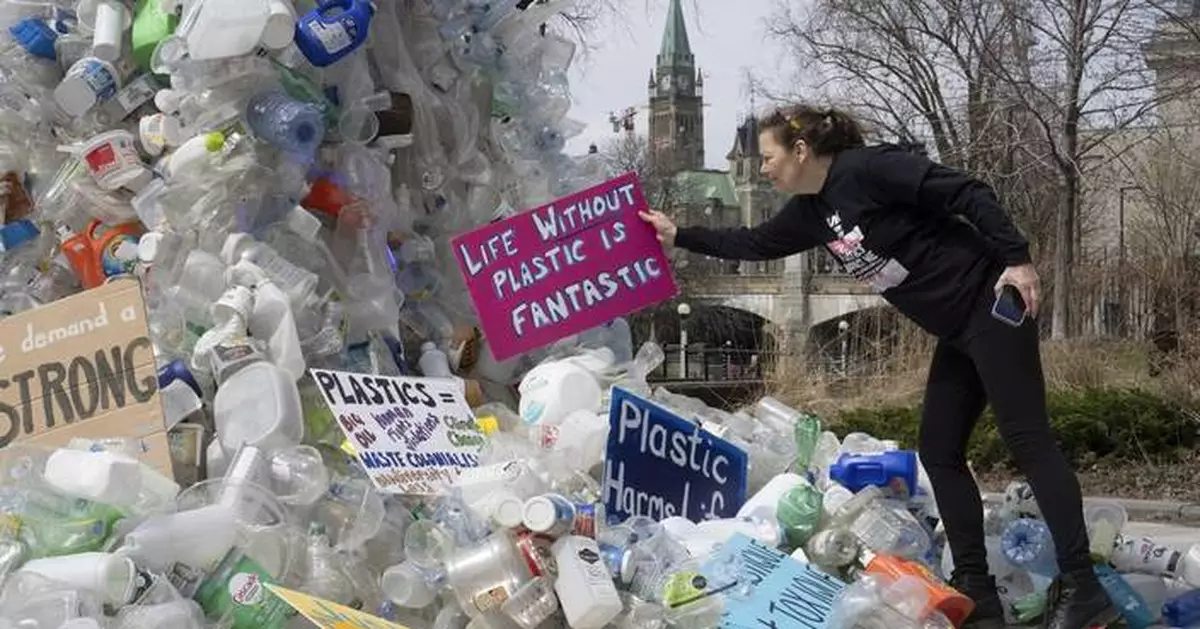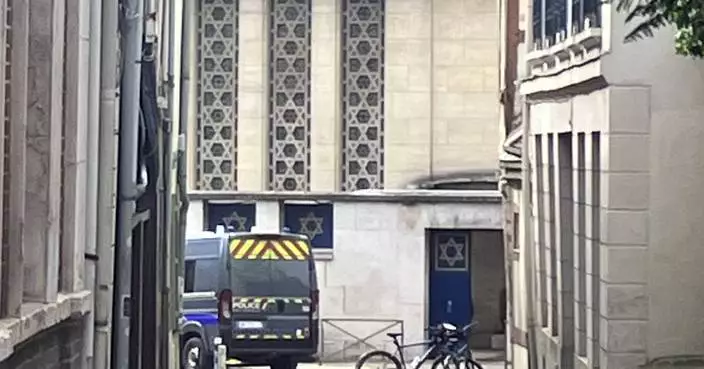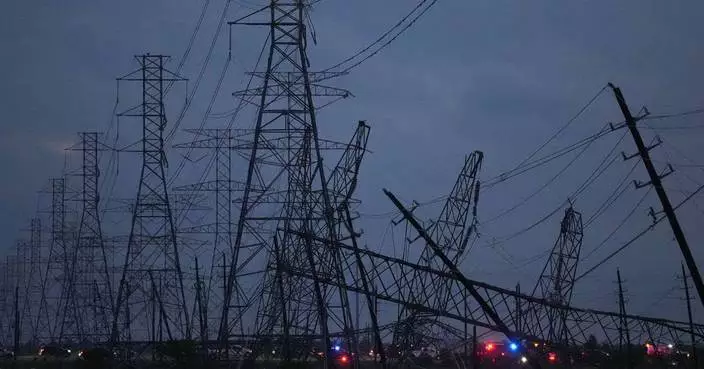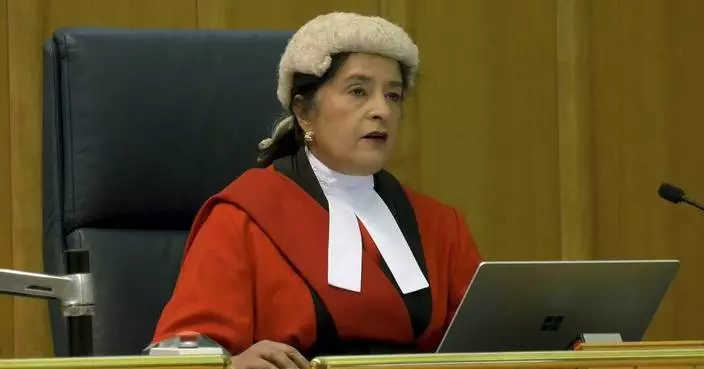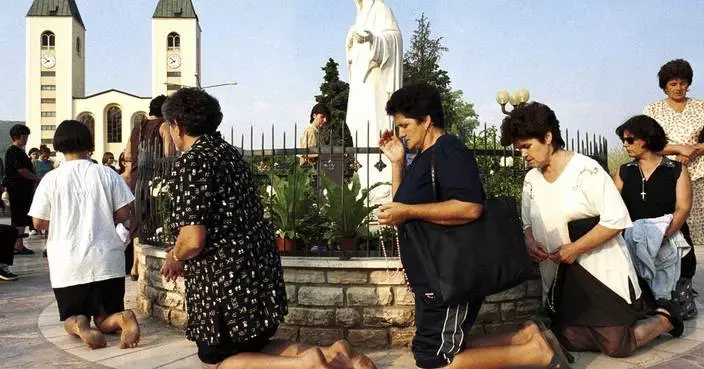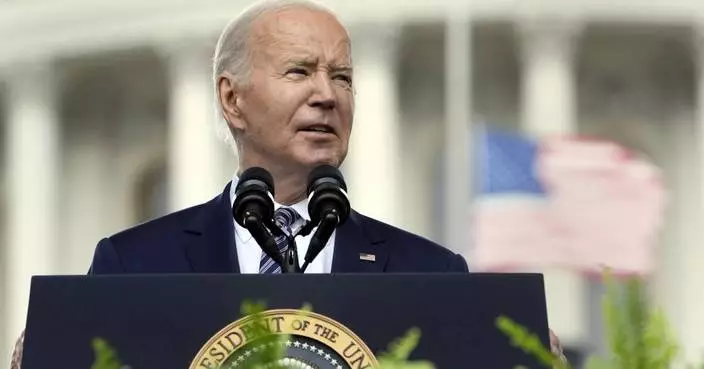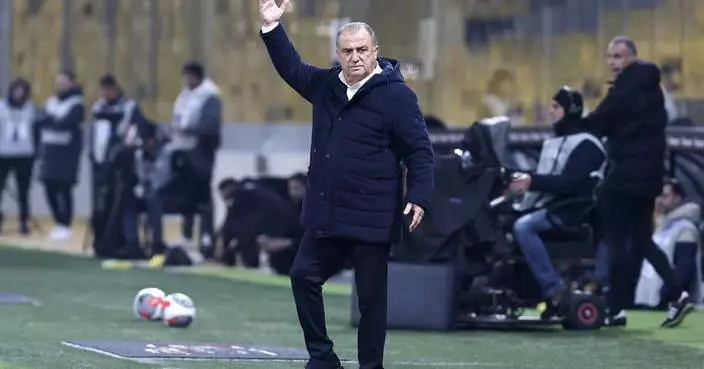OTTAWA, Ontario (AP) — Nations made progress on a treaty to end plastic pollution, finishing the latest round of negotiations in Canada early Tuesday amid sharp disagreements about whether to put global limits on plastic production.
For the first time in the process, negotiators discussed the text of what is supposed to become a global treaty. Delegates and observers at the Intergovernmental Negotiating Committee on Plastic Pollution called it a welcome sign that talk shifted from ideas to treaty language at this fourth of five scheduled meetings.
Most contentious is the idea of limiting how much plastic is manufactured. That remains in the text over the strong objections of plastic-producing countries and companies and oil and gas exporters. Most plastic is made from fossil fuels and chemicals.
As the Ottawa session ended, the committee agreed to keep working on the treaty before its final meeting later this year in South Korea.
The preparations for that session will focus on how to finance the implementation of the treaty, assess the chemicals of concern in plastic products and look at product design. Rwanda’s representative said negotiators ignored the elephant in the room by not addressing plastic production.
“In the end, this is not just about the text, it’s not just about the process," said Jyoti Mathur-Filipp, executive secretary of the committee. "It is quite simply about providing a better future for generations and for our loved ones.”
Stewart Harris, an industry spokesperson with the International Council of Chemical Associations, said the members want a treaty that focuses on recycling plastic and reuse, sometimes referred to as “circularity.”
They don't want a cap on plastic production, and think chemicals should not be regulated through this agreement. Harris said the association was pleased to see governments coming together and agreeing to complete additional work, especially on financing and plastic product design.
Dozens of scientists from the Scientists’ Coalition for an Effective Plastics Treaty came to the meeting to provide research on plastic pollution to negotiators, in part, they said, to dispel misinformation.
“I heard yesterday that there’s no data on microplastics, which is verifiably false: 21,000 publications on micro and nanoplastics have been published,” said Bethanie Carney Almroth, an ecotoxicology professor at Sweden's University of Gothenburg who co-leads the coalition. “It’s like Whac-A-Mole.”
She said scientists were being harassed and intimidated by lobbyists and she reported to the U.N. that a lobbyist yelled in her face at a meeting.
Despite their differences, the countries represented share a common vision to move forward in the treaty process, Ecuador's chief negotiator, Walter Schuldt, said.
“Because at the end of the day, we’re talking about the survival of the future of life, not only of human life but all sorts of life on this planet,” he said in an interview.
The treaty talks began in Uruguay in December 2022 after Rwanda and Peru proposed the resolution that launched the process in March 2022. Progress was slow during Paris talks in May 2023 and in Nairobi in November as countries debated rules for the process.
When thousands of negotiators and observers arrived in Ottawa, Luis Vayas Valdivieso, the committee chair from Ecuador, reminded them of their purpose to deliver a future free of plastic pollution. He asked them to be ambitious.
The delegates have been discussing not only the scope of the treaty, but chemicals of concern, problematic and avoidable plastics, product design, and financing and implementation.
Delegates also streamlined the unwieldy collection of options that emerged from the last meeting.
“We took a major step forward after two years of lots of discussion. Now we have text to negotiate,” said Björn Beeler, international coordinator for the International Pollutants Elimination Network. “Unfortunately, much more political will is needed to address the out of control escalating plastic production.”
Many traveled to Ottawa from communities affected by plastic manufacturing and pollution. Louisiana and Texas residents who live near petrochemical plants and refineries handed out postcards aimed at the U.S. State Department saying, “Wish you were here."
They traveled together as a group from the Break Free From Plastic movement, and asked negotiators to visit their states to experience the air and water pollution firsthand.
“This is still the best option we have to see change in our communities. They’re so captured by corporations. I can't go to the parish government,” said Jo Banner, of the St. John the Baptist Parish in Louisiana. “It feels this is the only chance and hope I have of helping my community repair from this, to heal.”
Members of an Indigenous Peoples’ Caucus held a news conference Saturday to say microplastics are contaminating their food supply and the pollution threatens their communities and ways of life guaranteed to them in perpetuity. They felt their voices weren’t being heard.
“We have bigger stakes. These are our ancestral lands that are being polluted with plastic,” Juressa Lee of New Zealand said after the event. “We’re rightsholders, not stakeholders. We should have more space to speak and make decisions than the people causing the problem.”
In the Bay of Plenty, a source of seafood on New Zealand's northern coast, the sediment and shellfish are full of tiny plastic particles. They regard nature's “resources” as treasures, Lee added.
“Indigenous ways can lead the way," Lee said. "What we're doing now clearly is not working.”
Vi Waghiyi traveled from Alaska to represent Arctic Indigenous peoples. She's reminding decision-makers that this treaty must protect people from plastic pollution for generations to come.
She said, “We come here to be the conscience, to ensure they make the right decision for all people.”
The Associated Press’ climate and environmental coverage receives financial support from multiple private foundations. AP is solely responsible for all content. Find AP’s standards for working with philanthropies, a list of supporters and funded coverage areas at AP.org.

FILE - A sign sits amongst plastic on a public art installation outside a United Nations conference on plastics on April 23, 2024, in Ottawa, Ontario. (Adrian Wyld/The Canadian Press via AP, File)

FILE - Minister of Environment and Climate Change Steven Guilbeault looks on as Chairperson of the Intergovernmental Negotiating Committee Ambassador Luis Vayas Valdivieso speaks during a news conference, April 23, 2024, in Ottawa, Ontario. (Adrian Wyld/The Canadian Press via AP, File)
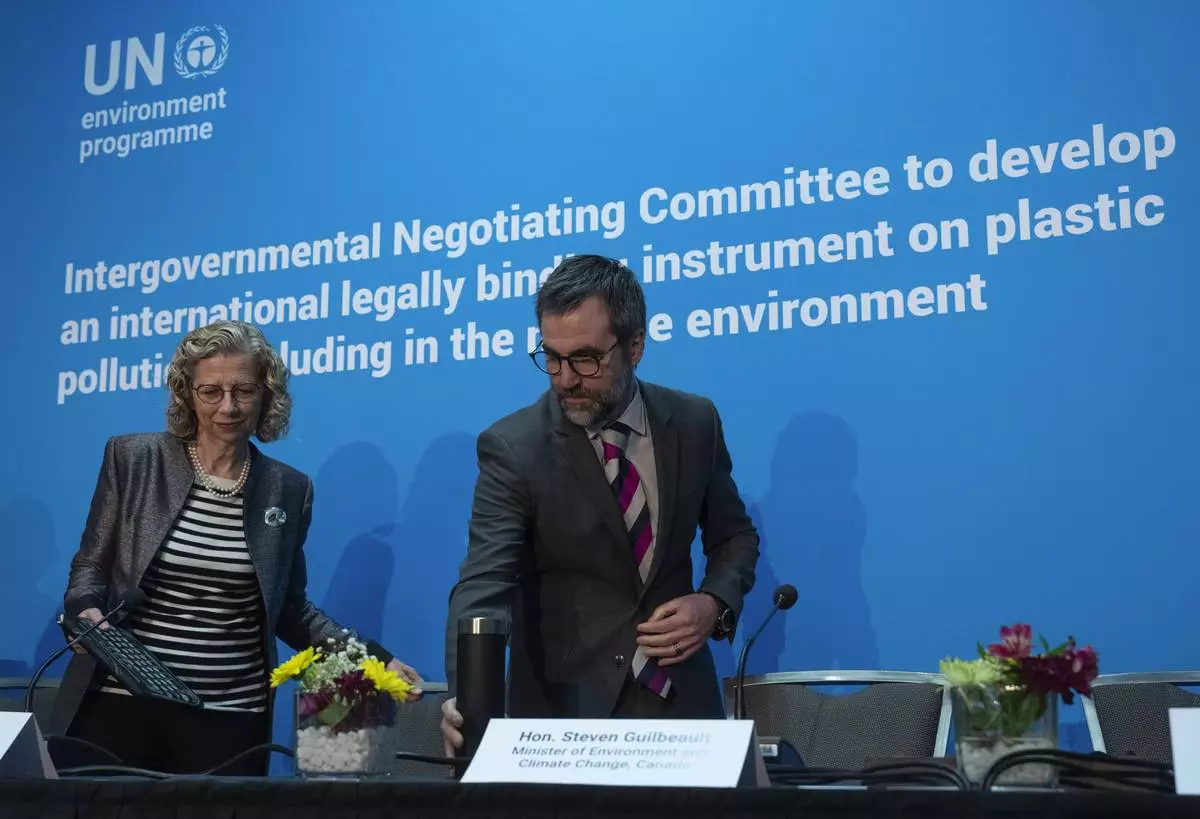
FILE - United Nations Environment Programme Executive Director Inger Andersen and Environment and Climate Change Minister Steven Guilbeault take their seats at a news conference, April 23, 2024 in Ottawa, Ontario. (Adrian Wyld/The Canadian Press via AP, File)
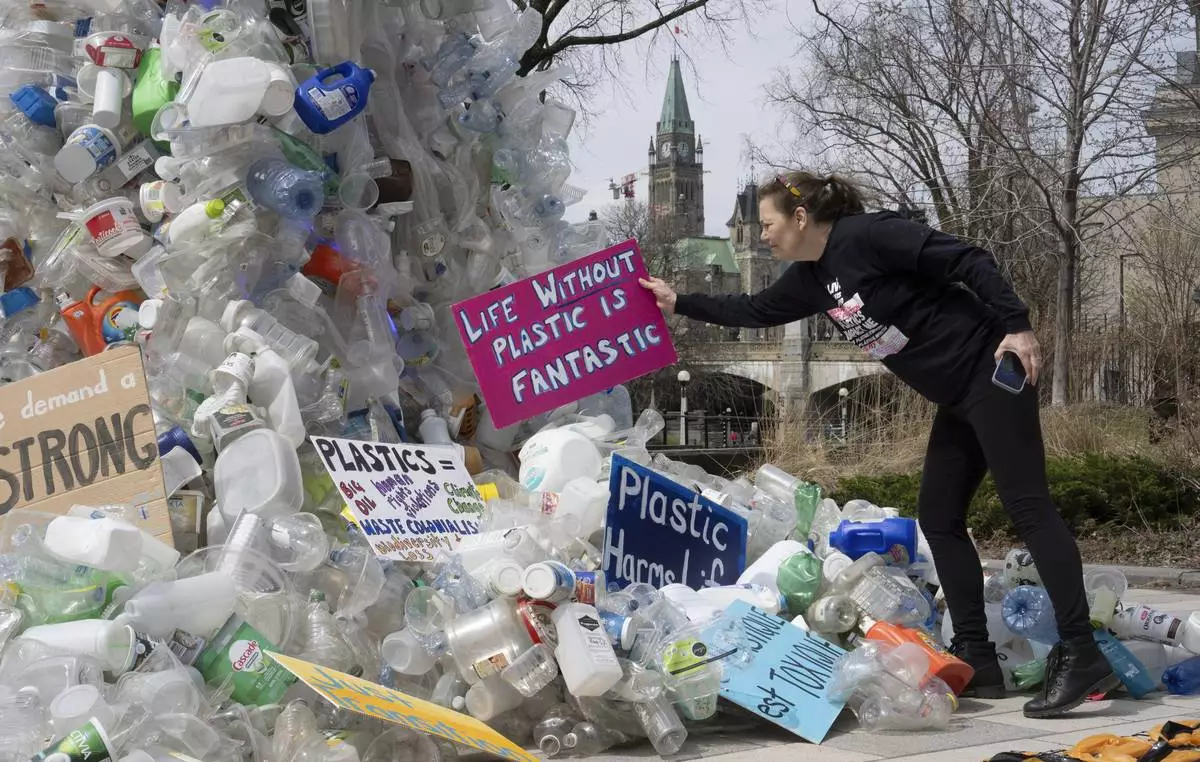
FILE - Activist Dianne Peterson places a sign on an art installation outside a United Nations conference on plastics, April 23, 2024, in Ottawa, Ontario. (Adrian Wyld/The Canadian Press via AP. File)
BEIRUT (AP) — The Lebanese militant group Hezbollah this week struck a military post in northern Israel using a drone that fired two missiles. The attack wounded three soldiers, one of them seriously, according to the Israeli military.
Hezbollah has regularly fired missiles across the border with Israel over the past seven months, but the one on Thursday appears to have been the first successful missile airstrike it has launched from within Israeli airspace.
The group has stepped up its attacks on Israel in recent weeks, particularly since the Israeli incursion into the southern city of Rafah in the Gaza Strip. It has struck deeper inside Israel and introduced new and more advanced weaponry.
“This is a method of sending messages on the ground to the Israeli enemy, meaning that this is part of what we have, and if needed we can strike more,” said Lebanese political analyst Faisal Abdul-Sater who closely follows Hezbollah.
While the cross-border exchanges of fire have been ongoing since early October, “complex attacks” by Hezbollah began a few days after Iran’s unprecedented drone and missile barrage attack on Israel in mid-April.
In the past two weeks, Hezbollah has escalated further in response to the Israeli incursion into the city of southern Rafah in the Gaza Strip, a Lebanese official familiar with the group’s operations said. The official spoke on condition of anonymity because he was not authorized to detail military information to the media.
The Thursday afternoon attack by a drone carrying missiles came just days after Hezbollah launched three anti-tank guided missiles at an Israeli military post that controlled a surveillance balloon flying over the border. They released camera footage afterward to show they had hit their mark. Hours later, the Israeli military confirmed that the spy balloon had been shot down over Lebanon.
The night before, Hezbollah had carried out its deepest attack in Israel to date using explosive drones to strike at a base in Ilaniya near the city of Tiberias about 35 kilometers (22 miles) from the Lebanon border. The Israeli military said the attack did not hurt anyone.
Abdul-Sater, the analyst, said the Iran-led coalition known as the axis of resistance, which includes the Palestinian militant group Hamas, has warned that if Israeli troops launch a full-scale invasion of Rafah in an attempt to go after Hamas, other fronts will also escalate.
Yemen's Iran-backed Houthi rebels claimed Wednesday that they attacked a U.S. destroyer while Iran-backed militants in Iraq have said they fired a series of drones toward Israel in recent weeks after having gone relatively quiet since February.
Hezbollah's use of more advanced weaponry, including drones capable of firing missiles, explosive drones and the small type of guided missile known as Almas, or Diamond, that was used to attack the base controlling the balloon has raised alarms within the Israeli military.
“Hezbollah has been escalating the situation in the north,” said military spokesman Lt. Col. Nadav Shoshani. “They’ve been firing more and more.”
In adapting its attacks, Hezbollah has also managed to reduce the numbers of fighters lost compared with the early weeks of the conflict.
The group has lost more than 250 fighters so far, compared with 15 Israeli troops since fighting broke out along the Lebanon-Israel border a day after the Israel-Hamas war started on Oct. 7.
According to a count by The Associated Press, Hezbollah lost 47 fighters in October and 35 in November, compared with 20 in April and 12 so far this month.
The official familiar with the group’s operations said Hezbollah had reduced the numbers of fighters along the border areas to bring down the numbers of casualties. While Hezbollah continues to fire Russian-made anti-tank Kornet missiles from areas close to the border, it has also shifted to firing drones and other types of rockets with heavy warheads — including Almas as well as Falaq and Burkan rockets — from areas several kilometers (miles) from the border.
Over the weekend, Hezbollah said it had launched a new rocket with a heavy warhead named Jihad Mughniyeh after a senior operative who was killed in an Israeli airstrike on southern Syria in 2015.
Eva J. Koulouriotis, a political analyst specialized in the Middle East and jihadi groups wrote on the social media platform X that Hezbollah's recent escalation likely has several goals, including raising the ceiling of the group's demands in any future negotiations for a border deal, as well as raising military pressure on Israel's military in light of the preparations for the battle in Rafah.
Israel’s Defense Minister Yoav Gallant vowed in a speech last week that “we will stand, we will achieve our goals, we will hit Hamas, we will destroy Hezbollah, and we will bring security.”
On Monday, Hezbollah leader Hassan Nasrallah reiterated in a speech that there will be no end to the fighting along the Lebanon-Israel border until Israel’s military operations in the Gaza Strip come to an end.
“The main goal of Lebanon’s front is to contribute to the pressure on the enemy to end the war on Gaza,” Nasrallah said.
His comments were a blow to attempts by foreign dignitaries, including U.S. and French officials, who have visited Beirut t o try to put an end to the violence that has displaced tens of thousands of people on both sides of the border.
A day after Nasrallah spoke, Canada’s Foreign Minister Mélanie Joly visited Beirut and told Lebanon’s private LBC TV station that she was pushing for a cease-fire.
“We need the people living in the south of Lebanon to be able to go back to their homes," she said. "We need to make sure that the Israelis living in the northern part of Israel are able to get back to their homes also.”
Hezbollah’s deputy leader Naim Kassim warned Israel in a speech over the weekend against opening an all-out war.
“You have tried in the past and you were defeated and if you try again you will be defeated,” said Kassim, referring to the 2006 Israel-Hezbollah 34-day war that ended in a draw.
Associated Press writer Sam Mednick contributed to this report from Jerusalem.
Find more of AP's coverage at https://apnews.com/hub/israel-hamas-war

Lebanese soldiers block a road that links to the scene where Israeli airstrikes attacked a vehicle and a small brick factory, in Najariyeh village, south Lebanon, May 17, 2024. Three separate drone strikes on a coastal village in south Lebanon Friday killed three people, including two Syrian citizens, security officials said. (AP Photo/Mohammed Zaatari)

Lebanese soldiers and Red Cross volunteers gather at a block road that links to the scene where Israeli airstrikes attacked a vehicle and a small brick factory, in Najariyeh village, south Lebanon, May 17, 2024. Three separate drone strikes on a coastal village in south Lebanon Friday killed three people, including two Syrian citizens, security officials said. (AP Photo/Mohammed Zaatari)

FILE - Fighters from the Lebanese militant group Hezbollah carry out a training exercise in Aaramta village in the Jezzine District, southern Lebanon, Sunday, May 21, 2023. Lebanon's Hezbollah group is introducing new tactics and weapons against Israel as the war in Gaza drags on and Israeli troops enter parts of the southern city of Rafah. In mid-May 2024, Hezbollah has used a drone equipped with missiles to attack an Israeli post as well as an explosive drone to hit its deepest target so far since the clashes began seven months ago. (AP Photo/Hassan Ammar, File)

FILE - Family follow in grief as soldiers carry the casket of Israeli reserve Major Dor Zimel at his funeral in Even Yehuda, Israel, Monday, April 22, 2024. Zimel, 27, died after Iran-backed Lebanese militant Hezbollah group fired a volley of rockets and drones on northern Israel. The Hezbollah group is introducing new tactics and weapons against Israel as the war in Gaza drags on. In mid-May 2024, Hezbollah has used a drone equipped with missiles to attack an Israeli post as well as an explosive drone to hit its deepest target so far since the clashes began seven months ago. (AP Photo/Ariel Schalit, File)

FILE - Israeli soldiers deploy between the houses in the Israeli town of Metula, as seen from the Lebanese side of the Lebanese-Israeli border in the southern village of Kfar Kila, Lebanon, Sunday, Oct. 8, 2023. Lebanon's militant Hezbollah group is introducing new tactics and weapons against Israel as the war in Gaza drags on. In mid-May 2024, Hezbollah has used a drone equipped with missiles to attack an Israeli post as well as an explosive drone to hit its deepest target so far since the clashes began seven months ago. (AP Photo/Hussein Malla, File)

FILE - An Israeli house in the northern Israeli border town of Metula, which was damaged by Hezbollah shelling, is seen from the Lebanese side of the Lebanese-Israeli border village of Kfar Kila, south Lebanon, Thursday, April 18, 2024. Lebanon's militant Hezbollah group is introducing new tactics and weapons against Israel as the war in Gaza drags on and Israeli troops enter parts of the southern city of Rafah. (AP Photo/Mohammed Zaatari, File)

FILE - Israeli security forces examine the site hit by a rocket fired from Lebanon, in Kiryat Shmona, northern Israel, Wednesday, March 27, 2024. Lebanon's militant Hezbollah group is introducing new tactics and weapons against Israel as the war in Gaza drags on and Israeli troops enter parts of the southern city of Rafah. In mid-May 2024, Hezbollah has used a drone equipped with missiles to attack an Israeli post as well as an explosive drone to hit its deepest target so far since the clashes began seven months ago. (AP Photo/Ariel Schalit, File)

FILE - Israeli soldiers carry the casket of Israeli reserve Major Dor Zimel during his funeral in Even Yehuda, Israel, Monday, April 22, 2024. Zimel, 27, died of his wounds after Iran-backed Lebanese militant Hezbollah group fired a volley of rockets and drones on northern Israel. In mid-May 2024, Hezbollah has used a drone equipped with missiles to attack an Israeli post as well as an explosive drone to hit its deepest target so far since the clashes began seven months ago. (AP Photo/Ariel Schalit, File)

FILE - Smoke rises from inside an Israeli army position which was hit by Hezbollah fighters as seen from Tair Harfa village, a Lebanese border village with Israel, south Lebanon, Friday, Oct. 20, 2023. Lebanon's militant Hezbollah group is introducing new tactics and weapons against Israel as the war in Gaza drags on and Israeli troops enter parts of the southern city of Rafah. In mid-May 2024, Hezbollah has used a drone equipped with missiles to attack an Israeli post as well as an explosive drone to hit its deepest target so far since the clashes began seven months ago. (AP Photo/Hassan Ammar, File)

FILE - Israeli security forces examine the site hit by a rocket fired from Lebanon, in Kiryat Shmona, northern Israel, Wednesday, March 27, 2024. Lebanon's militant Hezbollah group is introducing new tactics and weapons against Israel as the war in Gaza drags on and Israeli troops enter parts of the southern city of Rafah. In mid-May 2024, Hezbollah has used a drone equipped with missiles to attack an Israeli post as well as an explosive drone to hit its deepest target so far since the clashes began seven months ago. (AP Photo/Ariel Schalit, File)

FILE - The fence of an Israeli military position is seen damaged after Hezbollah targeted it by rockets, on an occupied hill of Kfar Chouba village, southeast Lebanon, Sunday, Oct. 8, 2023. Lebanon's militant Hezbollah group is introducing new tactics and weapons against Israel as the war in Gaza drags on and Israeli troops enter parts of the southern city of Rafah. In mid-May 2024, Hezbollah has used a drone equipped with missiles to attack an Israeli post as well as an explosive drone to hit its deepest target so far since the clashes began seven months ago. (AP Photo/Hussein Malla, File)






